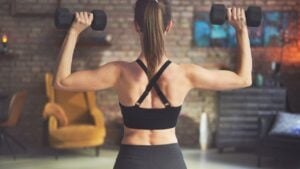If you’re one of the fitness enthusiasts who love working out at home and looking for alternatives to bar dips, you’ve come to the perfect place.
In this article, I’ll show you the eight best ways to do dips at home that require no special equipment other than what you already have in your house.
Learning how to do dips at home in various ways provides you with more options to choose from when creating a bodyweight workout plan.
Dips are an excellent upper-body exercise to build strength and muscle, primarily in the triceps region.1 McKenzie A, Crowley-McHattan Z, Meir R, Whitting J, Volschenk W. Bench, Bar, and Ring Dips: Do Kinematics and Muscle Activity Differ?. Int J Environ Res Public Health. 2022;19(20):13211. Published 2022 Oct 14. doi:10.3390/ijerph192013211
Let’s explore how to perform different dip variations without proper equipment and their benefits.
Muscles Worked During Dips Exercise

The dip workout is a push movement. It strengthens the upper body muscles, such as the triceps, chest, shoulders, abs, and biceps.
Here are the three primary muscles engaged during the different dip variations:
Triceps: The tricep is a three-headed muscle (long, lateral, and medial head) located on the back of your upper arms, opposite the biceps muscles. It is the primary muscle work during bench, floor, and kitchen counter dips.2 How to Do Chair Dips (Medically reviewed by Daniel Bubnis, M.S., NASM-CPT, NASE Level II-CSS – Written by Ashley Marcin) – Healthline.com
Shoulders: The shoulder is a group of three muscles: the anterior, lateral, and posterior deltoids. The anterior deltoid is the one that works mostly when you perform the dip exercise.
Chest: The chest or pectorals are one of the largest upper body muscles. It engages most when you perform dips on the bar.
Dips Workout Benefits
Here are some of the crucial benefits of doing bodyweight dips:
- Dips are excellent for developing upper body muscles, especially the triceps. An ACE-sponsored study has shown that dips quickly and effectively tone and strengthen the triceps muscles.3 ACE Study Identifies Best Triceps Exercises By Brittany Boehler, B.S., John P. Porcari, Ph.D., Dennis Kline, M.S., C. Russell Hendrix, Ph.D., and Carl Foster, Ph.D., with Mark Anders So, if you have limited time, you can do dips to build sturdy triceps.
- Dips stabilize and strengthen muscles and efficiently help you perform other compound exercises, such as bench press and military press.
- Most of us are unaware that dips also improve flexibility and help us perform better during calisthenics push exercises.
- Some dip variations, like floor dips or kitchen counter dips, strengthen abs and increase core muscle endurance.
Dips are good for building stronger triceps. However, bench dips are also bad for the shoulders if done incorrectly.
Dips can overstretch the shoulder joint, making it less stable and more prone to injury. When lowering during dips, the upper arm bone extends and rotates inward, which can pinch the shoulder. This also rounds the shoulders, weakening stability around the shoulder blades and chest.4 Follow-up Q and A: Dangerous Dips (American Council of Exercise)
The 8 Best Ways To Do Dips At Home

- Using A Chair
- On The Floor
- On The Kitchen Counter
- Using a Table
- On A Sofa
- Wearing a belt, dumbbell, or weighted school bag when you do a weighted dip
- Parallel dips on a pair of chairs
- On The Floor or Chair If You Do Single-Leg Dips
If getting a dip station in your home gym isn’t possible, you can use any of the above ways to perform dips at home. Below is a step-by-step guide on how to do dips at home using different things.
1. Chair Dips
The chair dip, also known as the tricep dip, is an excellent exercise to engage all three heads of the triceps muscles. It is easy, effective, and requires no special equipment other than a chair, and you can easily do it in the comfort of your own home.
Here’s how to do chair dips at home:
- First, stand against a chair so that your face is facing away.
- Then, sit on the chair with your arms straight at your sides and feet flat on the ground.
- Position your hands properly (fingers pointing out), lift your butt off the chair, and slightly move your torso forward while keeping your arms straight on the chair.
- Spread your legs in front of you with your heels touching the ground.
- Bend your elbows and lower your body as low as possible.
- Pressing through your hands, extend your elbows until your arms are entirely straight. That’s your one rep. Aim for three sets of 10 to 15 reps.
2. Floor Dips
No worries if you don’t have a chair, bench, or box, because you can still perform dips on the floor. The floor dip sometimes called the child dip, helps strengthen and tone the upper arms with no equipment.
It requires you to use your entire body weight, so it also works on the legs and improves the overall lower-body stability.
How to do a floor dip at home:
- Sit on the floor with your hands at your sides and knees bent to 60-90 degrees.
- Keep your arms straight underneath your shoulders and lift your hips 6-8 inches off the floor.
- Bend your elbows and lower your body toward the floor as deeply as possible.
- Then, pushing through your palms, extend your elbows until you feel the full contraction in your triceps. That’s your one rep. Aim for 3-4 sets of eight to ten reps.
3. Kitchen Counter Dips
You can do a counter dip in the kitchen of your home. Almost every kitchen countertop has a corner where you can perform several exercises, including dips. The counter dips primarily work on the pecs and triceps and help you build muscles at home.
However, it is slightly challenging compared to other dip workouts. Because during this exercise, you have to press the entire body weight, like push-ups.
Let’s see how to perform a dip using a countertop corner in your kitchen:
- Stand upright in front of the kitchen counter corner, place your hands on it, and slightly lean your torso forward.
- Hoist yourself up, bend your knees to a 60 to 90-degree angle, and keep your legs crossed.
- Bending your elbows, lower your body until your knees are close to the floor.
- Pushing through your palms, extend your arms in a controlled range of motion until they are straight. Aim for three to four sets of 8 to 10 repetitions.
4. Tabletop Dips
The tabletop dip is an easier variation of dip exercises. It is similar to a chair dip but on a table, so you can perform either of them.
How to perform tabletop dips at home.
- Sit on the edge of a table with your arms straight at your sides and knees bent to 90 degrees.
- Keep your palms firmly on the bench and tightly grip the edge with your fingers.
- Dip down as much as possible and then press back to return to the initial position.
- Keep your back straight during the entire movement, and make sure your elbows are tucked into your sides so that they don’t flare outward. Shoot for two or more sets of 15 to 20 repetitions.
5. Front Dips on Sofa
If you have a sofa or couch in your home, you can even do dips on it. The couch dip strengthens the tricep muscles, stabilizes the shoulder joint, and improves balance.

Steps to perform sofa dips at home:
- Sit on the couch with your hands beside you and arms straight.
- Walk your feet out, bend your knees, and make sure your torso is perpendicular to the floor.
- Bending your elbows, dip down until your butt is close to the floor.
- Extend your arms until you feel the full contraction in your triceps.
- Keep your shoulder back and down by adjusting your hand’s position.
6. Weighted Dips at Home
If you want to challenge your strength or scale up your fitness level, you can add additional weights to a dip workout.
For example, clamp a dumbbell between your feet, wear a weight belt or straps with a heavy object, use a weighted vest, or put a school or college bag on your shoulder with books or other stuff in it.
You can use weight in any dip variation that suits you the best.
7. Parallel Dips
You don’t always need a dip machine to perform a parallel bar dip. You can even do that by using a pair of chairs.
Doing parallel dips on chairs helps enhance grip strength, solidify triceps, and improve mobility so you can perform other tricep bodyweight exercises efficiently, such as diamond pushups and ring dips.
To perform parallel dips at home:
- Position two chairs with some space between them where you can dip.
- Place your hands on them and keep your arms straight.
- Next, slightly lean forward, hoist yourself up, and bend your knees behind.
- Now, perform dips as many times as you can.
If the chairs wobble, you can place them under the mat and put heavy objects on them, or ask your friends or family members to sit on the chairs while you perform dips.
The other alternative to a parallel bar dip is a ring dip, which you can do on a gymnastics ring.
8. Single-Leg Dip
If you want to improve your balance while gaining strength in your upper arms, you can try single-leg dips.
The single-leg dip is an advanced variation of home dip exercises that requires keeping one leg off the floor. You can do it on the floor or the bench.
How to perform a single-leg dip at home:
- Sit on the floor with your hands at your sides.
- Walk your feet out and bend your knees at 90 degrees. Make sure your torso is perpendicular to the floor, and your arms are straight underneath your shoulders.
- Hoist your butt, and lift your one leg off the floor.
- Bending your elbows, lower your body toward the floor, and press back through your palms as you push yourself up. Do two or more sets of 10 to 15 repetitions.
FAQs about Dips Workout
Can you do dips every day?
Dips are a compound exercise that works on several muscles at once throughout the upper body. It can also be done in several ways, so if you like to do it every day, you can try different variations on different days.
Are dips better than pushups?
Pushups and dips are great exercises for increasing strength, mobility, and muscular hypertrophy; however, they are not comparable. Both are good. Pushups work more chest while dips engage more tricep muscles, and a combination of both helps build a muscular and solid upper body, especially pecs and triceps.
Which surface is best for dips?
Chair: Great for home workouts; stable if sturdy. Good for a moderate range of motion.
Bench: Ideal for gym or park settings; allows deeper dips for advanced users.
Sofa: Softer and less stable; better for beginners, but ensure it’s firm and won’t slide.
Kitchen Counter: Stable and high, good for advanced dips, but ensure the edge is safe and non-slip.
Floor: Easiest option, best for beginners or those with limited mobility, but less range of motion.
What are the common mistakes to avoid?
Flaring Elbows: Keep elbows pointing back to target triceps and avoid shoulder strain.
Shrugging Shoulders: Keep shoulders back, down, and engaged.
Unstable Surfaces: Avoid wobbly chairs or sofas that could tip over.
Overextending Range: Don’t lower too far, as it can strain shoulders (stop at 90-degree elbow angle).
Poor Posture: Keep your core engaged and avoid hunching forward.
Applying these simple and important tips can help you achieve decent results while lowering the risk of injuries.
Are dips safe for everyone?
Dips can stress the shoulders and elbows, so they may not be suitable for those with: Shoulder injuries (like rotator cuff issues) and elbow or wrist pain. People with weak core or upper body strength should also be cautious while performing dips.
References
- 1McKenzie A, Crowley-McHattan Z, Meir R, Whitting J, Volschenk W. Bench, Bar, and Ring Dips: Do Kinematics and Muscle Activity Differ?. Int J Environ Res Public Health. 2022;19(20):13211. Published 2022 Oct 14. doi:10.3390/ijerph192013211
- 2How to Do Chair Dips (Medically reviewed by Daniel Bubnis, M.S., NASM-CPT, NASE Level II-CSS – Written by Ashley Marcin) – Healthline.com
- 3ACE Study Identifies Best Triceps Exercises By Brittany Boehler, B.S., John P. Porcari, Ph.D., Dennis Kline, M.S., C. Russell Hendrix, Ph.D., and Carl Foster, Ph.D., with Mark Anders
- 4Follow-up Q and A: Dangerous Dips (American Council of Exercise)






